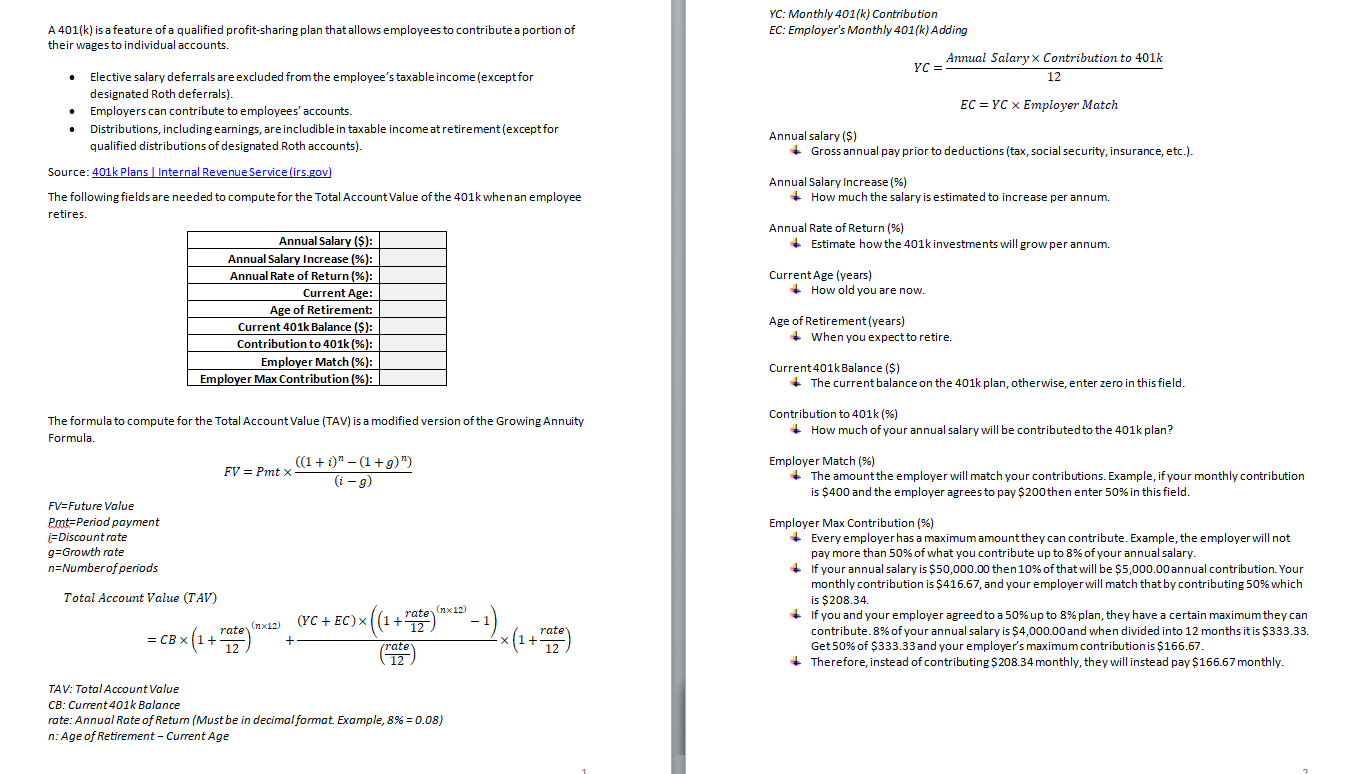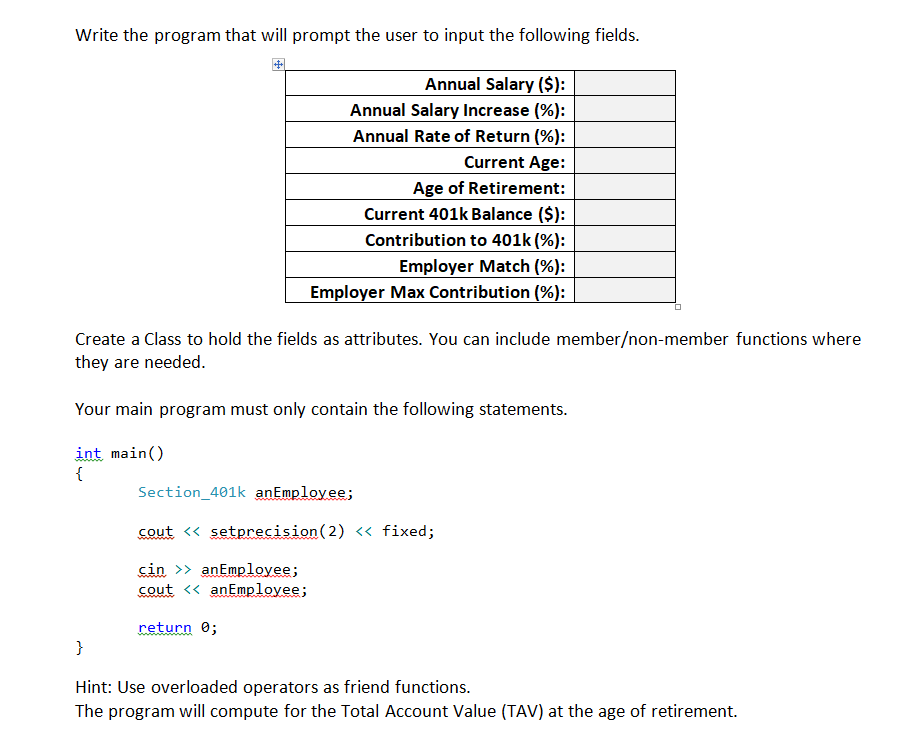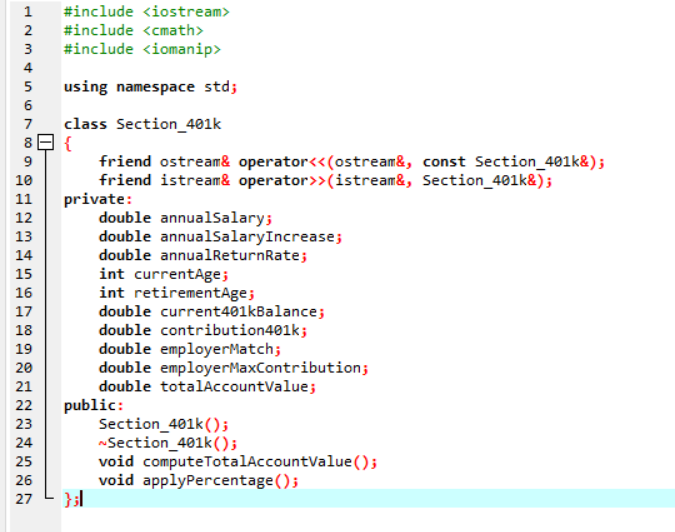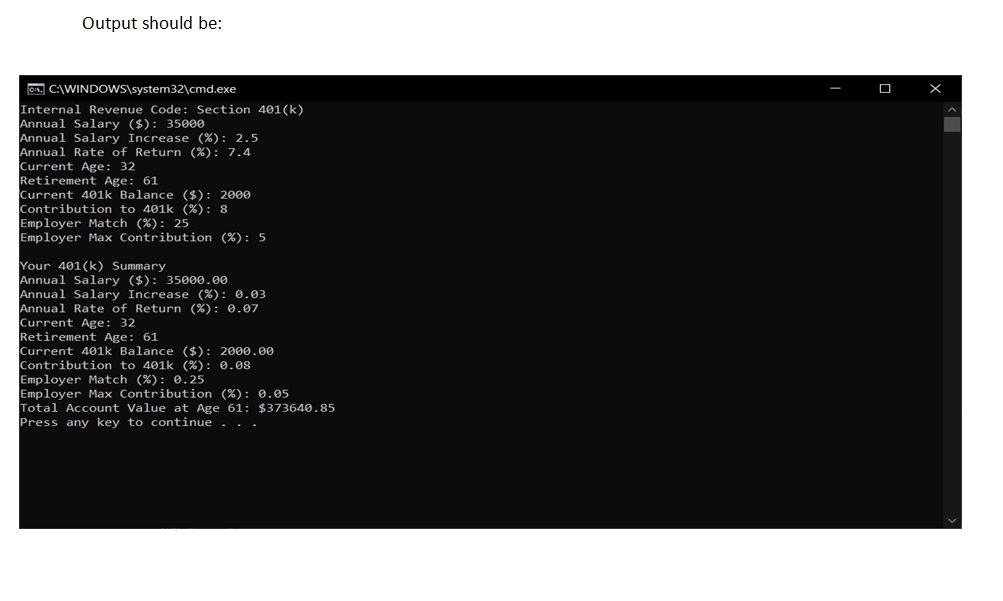Use C++ for the program and the guide given below




YC: Monthly 401(k) Contribution EC: Employer's Monthly 401(k) Adding A 401(k) is a feature of a qualified profit-sharing plan that allows employees to contribute a portion of their wages to individual accounts. Annual Salary x Contribution to 401k YC = 12 Elective salary deferrals are excluded from the employee's taxable income (except for designated Roth deferrals). Employers can contribute to employees' accounts. Distributions, including earnings are includible in taxable income at retirement (except for qualified distributions of designated Roth accounts). EC = YC X Employer Match Annual salary ($) + Gross annual pay prior to deductions (tax, social security, insurance, etc.). Source: 401k Plans Internal Revenue Service (irs.gov) The following fields are needed to compute for the Total Account Value of the 401k when an employee retires. Annual Salary Increase (%) + How much the salary is estimated to increase per annum. Annual Rate of Return (%) Estimate how the 401k investments will grow per annum. Current Age (years) + How old you are now. Annual Salary ($): Annual Salary Increase (%): Annual Rate of Return (%): Current Age: Age of Retirement: Current 401k Balance ($): Contribution to 401k (%): Employer Match (%): Employer Max Contribution (%): Age of Retirement (years) + When you expect to retire. Current 401k Balance ($) The current balance on the 401k plan, otherwise, enter zero in this field. Contribution to 401k (%) + How much of your annual salary will be contributed to the 401k plan? The formula to compute for the Total Account Value (TAV) is a modified version of the Growing Annuity Formula ((1+0)" -(1 +9)) FV = Pmt x (i -9) Employer Match (%) + The amount the employer will match your contributions. Example, if your monthly contribution is $400 and the employer agrees to pay $200 then enter 50% in this field. FV=Future Value Pmt=Period payment i=Discount rate g=Growth rate n=Number of periods Total Account Value (TAV) Employer Max Contribution (%) + Every employer has a maximum amount they can contribute. Example, the employer will not pay more than 50% of what you contribute up to 8% of your annual salary. + If your annual salary is $50,000.00 then 10% of that will be $5,000.00 annual contribution. Your monthly contribution is $416.67, and your employer will match that by contributing 50% which is $208.34. + If you and your employer agreed to a 50% up to 8% plan, they have a certain maximum they can contribute. 8% of your annual salary is $4,000.00 and when divided into 12 months it is $333.33. Get 50% of $333.33 and your employer's maximum contribution is $166.67. + Therefore, instead of contributing $208.34 monthly, they will instead pay $166.67 monthly. rate (X12) (YC + EC) (1 B =(1+2) rate x12 = CBX +12) Frate (12) *(1+ "ize) TAV: Total Account Value CB: Current 401k Balance rate: Annual Rate of Return (Must be in decimal format. Example, 8% = 0.08) n: Age of Retirement - Current Age Write the program that will prompt the user to input the following fields. Annual Salary($): Annual Salary Increase (%): Annual Rate of Return (%): Current Age: Age of Retirement: Current 401k Balance ($): Contribution to 401k (%): Employer Match (%): Employer Max Contribution (%): Create a Class to hold the fields as attributes. You can include memberon-member functions where they are needed. Your main program must only contain the following statements. int main() { Section_401k anEmployee; cout > anEmployee; cout 2 #include
3 #include 4 5 using namespace std; 6 7 class Section_401k 8{ 9 friend ostream& operator>(istream&, Section_401k&); 11 private: 12 double annualSalary; 13 double annualSalary Increase; 14 double annualReturnRate; 15 int currentAge; 16 int retirementAge; 17 double current401kBalance; 18 double contribution401k; 19 double employerMatch; 20 double employerMaxContribution; 21 double totalAccountValue; 22 public: 23 Section_401k(); 24 Section_401k(); 25 void computeTotalAccountValue(); 26 void applyPercentage(); 27 Output should be: OR. C:\WINDOWS\system32\cmd.exe Internal Revenue Code: Section 401(k) Annual Salary ($): 35000 Annual Salary Increase (%): 2.5 Annual Rate of Return (%): 7.4 Current Age: 32 Retirement Age: 61 Current 401k Balance ($): 2000 Contribution to 401k (%): 8 Employer Match (%): 25 Employer Max Contribution (%): 5 Your 401(k) Summary Annual Salary ($): 35000.00 Annual Salary Increase (%): 0.03 Annual Rate of Return (%): 0.07 Current Age: 32 Retirement Age: 61 Current 401k Balance ($): 2000.00 Contribution to 401k (%): 0.08 Employer Match (%): 0.25 Employer Max Contribution (%): 0.05 Total Account Value at Age 61: $373640.85 Press any key to continue










